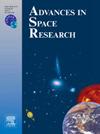两个太阳黑子群和 Gnevyshev-Waldmeier 规则
IF 2.8
3区 地球科学
Q2 ASTRONOMY & ASTROPHYSICS
引用次数: 0
摘要
根据英国皇家格林威治天文台的目录资料,继续对两种不同的太阳黑子群进行研究:LLG - 大型长寿命太阳黑子群,SSG - 小型短寿命太阳黑子群。目前正在解决的任务是实现比以前(Nagovitsyn & Pevtsov 2016, 2021)更高的群体分离参数精度。提出了每天观测一次的太阳黑子群寿命随机化程序,使统计研究达到更高的时间分辨率。采用 Gnevyshev-Waldmeier 规则的形式,将面积的对数与太阳黑子群的寿命(在有限的时间间隔内)线性连接起来。结果表明,SSG 和 LLG 群体的系数明显不同。研究发现,区分太阳黑子群的太阳黑子群寿命参数的取值范围为天数,这与之前获得的太阳黑子群观测天数的临界值:天数和天数是一致的。根据莱文伯格-马夸特方法,对太阳黑子群区域的双对数正态分布进行统计,并按寿命初步划分为对数正态分布。结果表明,在精确到十分之一天的情况下,SSG 群体对应于群体天的寿命,而 LLG 群体对应于倍天的寿命。所获得的结果使我们有可能独立研究 SSG 和 LLG 群体的各种物理特性,以便对它们进行比较并研究其性质。本文章由计算机程序翻译,如有差异,请以英文原文为准。
Two sunspot group populations and Gnevyshev-Waldmeier rule
Based on the materials of the Royal Greenwich Observatory catalog, the study of two different sunspot group populations continued: LLG – large long-lived, and SSG – small short-lived groups. The task of achieving a higher accuracy of the population separation parameter than before (Nagovitsyn & Pevtsov 2016, 2021) is being solved. A procedure for randomizing the lifetimes of sunspot groups observed once a day is proposed, which allows for statistical studies to achieve a higher time resolution. The form of the Gnevyshev-Waldmeier Rule is taken, which linearly connects the logarithm of the area and the lifetime of the sunspot group LT (over limited time intervals). It is shown that it has coefficients significantly different for SSG and LLG populations. The range of values of the group lifetime parameter separating the populations was found as days, which is in agreement with the threshold values obtained earlier for the number of days of sunspot group observation: days and days. It is shown that the parameters of the bilognormal distribution of the sunspot group areas, obtained from their common grouped sample statistically by Levenberg–Marquardt method and with a preliminary division into lognormal distributions by lifetime, correspond to each other. It was clarified that, with an accuracy of up to a tenth of a day, the SSG population corresponds to the lifetimes of groups days, and the LLG population corresponds to times days. The results obtained make it possible to study various physical properties of SSG and LLG populations independently of each other in order to compare them and study their nature.
求助全文
通过发布文献求助,成功后即可免费获取论文全文。
去求助
来源期刊

Advances in Space Research
地学天文-地球科学综合
CiteScore
5.20
自引率
11.50%
发文量
800
审稿时长
5.8 months
期刊介绍:
The COSPAR publication Advances in Space Research (ASR) is an open journal covering all areas of space research including: space studies of the Earth''s surface, meteorology, climate, the Earth-Moon system, planets and small bodies of the solar system, upper atmospheres, ionospheres and magnetospheres of the Earth and planets including reference atmospheres, space plasmas in the solar system, astrophysics from space, materials sciences in space, fundamental physics in space, space debris, space weather, Earth observations of space phenomena, etc.
NB: Please note that manuscripts related to life sciences as related to space are no more accepted for submission to Advances in Space Research. Such manuscripts should now be submitted to the new COSPAR Journal Life Sciences in Space Research (LSSR).
All submissions are reviewed by two scientists in the field. COSPAR is an interdisciplinary scientific organization concerned with the progress of space research on an international scale. Operating under the rules of ICSU, COSPAR ignores political considerations and considers all questions solely from the scientific viewpoint.
 求助内容:
求助内容: 应助结果提醒方式:
应助结果提醒方式:


